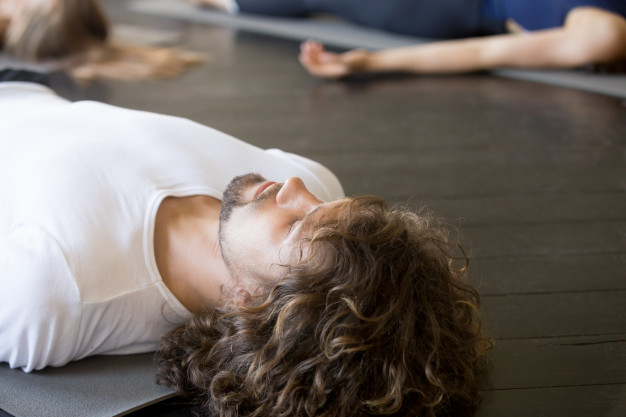
Introduction
Deep or slow-wave sleep is a critical sleep stage crucial for wholesome living. During deep sleep, the body goes through a restoration process. The body repairs and regenerates tissues to strengthen the immune system and regulates hormones that repair muscles and help build new muscles. In this article, we shall understand the benefits of yoga nidra for sleep.
The human brain and nervous system require deep sleep to function well. It eliminates toxins and other waste substances developed during the day, hence reducing the risk of neurological disorders such as Alzheimer’s disease.
Yoga Nidra brings about a state of total relaxation and calmness. It affects both physical and mental levels in multiple ways. Yoga Nidra can help an insomniac to have a deep sleep. Yoga Nidra can also help a person to quit their bad habits. Besides that, yoga nidra has various advantages, which we will cover further in this blog post.
What is Yoga Nidra
Yoga Nidra is an age-old technique That can reveal the undiscovered potential of the mind. Yoga Nidra is nothing but having a power nap with Awareness without losing consciousness. It’s an experience wherein the body and mind get relaxed due to absolute calmness and peacefulness.
Because of the instability of the mind, a large population is facing mental disturbances and psychological disorders, which results in hurting themselves physically or mentally.
Though Yoga Nidra is an ancient practice, it became more popular around 1960 when Swami Satyananda Saraswati was introduced to the public.
Difference between Meditation and Yoga Nidra:
Meditation is wiping away all the distractions of the mind. In meditation, a person tries to empty his mind. It is a state of being. For example, you are lost when you sit near the sea and watch waves.it is nothing but a meditative state.
In Yoga Nidra, a person may feel a short-term disassociation between body and mind, and at this time, you will have some pleasant experiences, and your body and mind will get relaxed and attain deep sleep.
The Science Behind Yoga Nidra for Sleep
Some scientific research confirms that Yoga Nidra helps our body go into the hypnagogic state, a diminishing state of consciousness and the beginning of sleep. In this state, brain waves slow down, and the body is asleep, but the mind is aware.
Researchers found that Yoga Nidra may help patients suffering from insomnia. Here You can find some more studies conducted by various organisations.
- Delivering integrative restoration-yoga nidra meditation to women with sexual trauma 🔗
- Effect of yoga-nidra on adolescents well-being 🔗
- Impact of Yoga Nidra on psychological general wellbeing in patients with menstrual irregularities 🔗
Benefits of Yoga Nidra for Sleep
- Yoga Nidra is a path to explore the immense potentiality of the mind. Regular practice of Yoga Nidra not only releases mental and physical tensions but revamps and refines a person’s personality.
- With the help of yoga Nidra, a person can eliminate his bad habits, which he has been trying to destroy for a long time. For those who practice meditation and want to attain more profound states of it, Yoga Nidra helps them to achieve it quickly.
- Yoga Nidra is straightforward for anyone, from a small kid to an older adult.
- Yoga Nidra helps a person to have a deep sleep. For those facing insomnia, though the objective of Yoga Nidra is not to get sleep over a period when a person attains relaxation of his mind, insomnia fades away automatically.
- Yoga Nidra is the most effective process for fulfilling a manifestation.
- In the state of deep relaxation, the receptivity of the mind is elevated significantly, and any resolution made at this time will undoubtedly be fulfilled in the future.
How to Practice Yoga Nidra for Sleep
During Yoga Nidra, consciousness travels from one surface of consciousness to another layer. Sometimes, yogic sleep will go too deep, and one can have fantastic experiences, but sometimes, it will not go so deep.
It is important to remember that you don’t have to concentrate; in a let-go and relaxing mood, you have to move your consciousness from one part of the body to another.
Step-by-step guide to an essential Yoga Nidra practice
Preparation and setting up a comfortable space
- Yoga Nidra should be performed in a quiet place, the temperature should be comfortable, and it should be free of insects. Privacy is essential, and all sudden interruptions must be avoided.
- Yoga Nidra should be performed in a dimly lighted room, neither in total darkness nor in a brightly lighted room. Practising it on an empty stomach or after 3 hours of taking any meal is advised.
- During Yog Nidra, it is crucial not to concentrate or fall into deep slumber.A cold shower should be taken if someone feels sleepy or practice is being done just before bed.
- During Yoga Nidra, you will occasionally observe your senses; at other times, you will flow away from them. When consciousness repeatedly swings away for a few moments, it turns between the unconscious and subconscious states.
How to do Yoga Nidra (Yoga Nidra Script)
- Lie on the floor or the Yoga mat in Corpse Pose (Shavasana). You can use a blanket and a small pillow for your head if required. In this position, the body should be straight from head to toe.
- Keep your Legs straight and slightly apart and the arms a bit away from the body. Keep the palms of your hands upwards, adjust your body and clothes until you are entirely comfortable, and prepare for Yoga Nidra.
- During Yog Nidra, any physical movement is not allowed.
- Now close your eyes, take a deep breath, and feel all your worries and negativities flowing out from your body as you exhale.
- Relax your body as you do just before you go to sleep. Resolve yourself that I will not sleep and remain awake throughout the practice.
- Repeat this resolution again and again in your mind that I will not sleep; I will not move my body.
- Be very attentive. If thoughts come to mind, do not worry—just practice. Keep in mind that I am awake and practising Yoga Nidra.
- Make you resolve a short positive manifestation about whatever you desire, e.g., total health, spiritual life, self-realization, anything. Repeat it three times in your mind.
- Now, we begin the rotation of Awareness as quickly as possible. Awareness will go from one part to another.
- Take your attention to the right hand, then fingers, palm, elbow, and shoulder. Now imagine a full right hand.
- Repeat the process with the left hand. Then, there are the legs, genital areas, stomach, chest, throat, face, and the top of the head. Take a deep breath and experience sensations in all parts of your body.
After practising it for some time, keep yourself aware of your surroundings, the yoga mat you are lying on, and the room in which you practice. Now, gently open your eyes, be in this state for some time, and slowly get up and sit comfortably.
Correct time Yoga Nidra Training
Yoga Nidra is so easy to perform that nobody can do it the wrong way, but it is advised that you perform Yoga Nidra after finishing the Yoga Asanas (Poses) sequence.
Yoga poses warm up the body parts, and when performing yoga, Nidra cools them down afterwards. Yoga Asanas energize the body, and practising yoga Nidra helps preserve and consolidate this energy, which relaxes the mind and body.
Common Challenges and Solutions
Yoga Nidra should not be practised impulsively. One should take sufficient time to perform this practice; 40-45 minutes are enough to gain the proper benefits of Yoga Nidra.
One should also be determined at the start of the process not to sleep during the process as the ultimate goal of yoga Nidra is not to sleep but to relax the entire system.
CONCLUSION
In this hectic life, people go to bed with stressed and agitated minds and never attain deep sleep. Those people can benefit by performing Yoga Nidra for sleep.
Which eventually results in many psychosomatic disorders and physical ailments. Yoga Nidra benefits them exponentially.


Pingback: 5 reasons why you always feel tired(How to fix this).
Pingback: Three Simple Ways how to improve Mental Health
jj